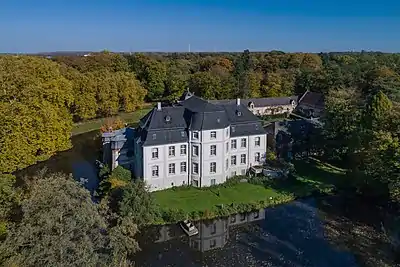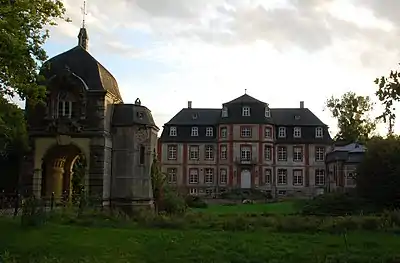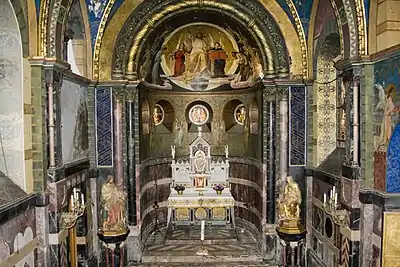Schloss Türnich
Schloss Türnich (German: Schloss Türnich) is a rococo Schloss in the Rhineland region of Germany. It is located in Türnich in the city of Kerpen, Rhein-Erft-Kreis, North Rhine-Westphalia. It is owned by the Van Hoensbroeck family, currently Godehard count von und zu Hoensbroech. In the outbuilding, there is a cafe.



History
Already in the middle ages, there was a moated castle in Türnich. It was already mentioned in 898. A knight called 'Winandus de Tornich' was mentioned in 1208. The current rococo mansion was constructed between 1757 and 1766 for Freiherr Carl-Ludwig von Rolshausen. Freiherr Georg-Karl von Rolshausen sells the manor to Reichsgraf Karl Eugen von und zu Hoensbroech in 1850.
Open-cast mining in the region has significantly lowered the levels of groundwater around the mansion (80 centimetres to even 2.8 metres on a certain moment), which has caused substantial damage to the main house. in 1979, the family had to move out of the house. With help of the local government of North Rhine-Westphalia, the city of Kerpen and Deutsche Stiftung Denkmalschutz restoration started in 2009. The colour on the facade has been renewed. And the von und zu Hoensbroech family is investigating how they can safe the house for the future.
Design and architecture
Presumably, the French court architect of the Electorate of Cologne, Michael Leveilly has been the designer of the mansion. The manor is a typical Maison de plaisance. The design is very similar to Jägerhof Palace in Düsseldorf as well as to Falkenlust Palace in Brühl - designed by François de Cuvilliés.
The Neo-Romanesque chapel is constructed in 1895 and dedicated to Elizabeth of Hungary. The mansion is surrounded by a baroque park, which is open to visitors.
Bibliography
- Heinz Firmenich, Helmut Rossen: Schloss Türnich. Gesellschaft für Buchdruckerei, Neuss 1975 (Rheinische Kunststätten. Nr. 175).
- Gemeinde Türnich: Türnich im Wandel der Zeit. Türnich 1974, S. 175–179, 228.
- Harald Herzog: Rheinische Schloßbauten im 19. Jahrhundert. Bonn 1981, ISBN 3-7927-0585-0, S. 29 ff, 164–172.
- Sabine Heuser-Hauck: Der Architekt Heinrich Krings (1875–1925). Dissertation an der Philosophischen Fakultät Bonn, Bonn 2005, S. 180–184.
- Norbert Hierl-Deronco: Es ist eine Lust zu bauen. Von Bauherren, Bauleuten und vom Bauen im Barock in Kurbayern-Franken-Rheinland. Eigenverlag, Krailling 2001, ISBN 3-929884-08-9.
- Hermann Hinz: Archäologische Funde und Denkmäler des Rheinlandes, Band 2. Kreis Bergheim, Düsseldorf 1969, S. 344–345.
- Frank Kretzschmar (Bearb.): Kirchen Klöster und Kapellen im Erftkreis. Rheinland-Verlag, Köln [1984], ISBN 3-7927-0821-3, S. 134–137 (Erftkreisveröffentlichung. Nr. 94).
- Henriette Meynen: Wasserburgen Schösser und Landsitze im Erftkreis. Köln 1979, ISBN 3-7927-0521-4, S. 104–109.
- Annaliese Ohm: Die Denkmäler des Rheinlandes. Königshoven-Türnich. Rheinland-Verlag, Düsseldorf 1971, ISBN 3-508-00186-5, S. 97–99, 103–104.
External links
| Wikimedia Commons has media related to Category:Schloss Tuernich. |